
| Wes Boyd's Spearfish Lake Tales Contemporary Mainstream Books and Serials Online |

Whitmore Wash, Diamond Creek Wash, Bridge Canyon Camp (Mile 238)

| Wes Boyd's Spearfish Lake Tales Contemporary Mainstream Books and Serials Online |

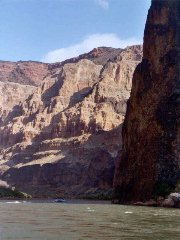 |
|
On the river below Angel's Camp, our last full day on the river. |
This time, I was pretty far from the kitchen, but heard the propane burners soon after the crew lit them off well before dawn. Noisy as they are, they're preferable to the electronic beeping of an alarm clock. The wind had kept up all night, but was muted to a strong breeze, now, and the invader tamarisks had kept me well protected.
As I was packing up, Joe came wandering around, and noted that he thought that the day would be warm, that we'd be stopping in places where we might want to go swimming, and I might want to wear a swim suit. I changed into mine, for only the second time on the trip. However, when we got on the river after breakfast, it remained largely overcast and cold, and I was wishing I'd worn the polypro as a bottom layer, rather than the swim suit. Fortunately, there were no particularly large rapids this morning, only some small ones, so we managed to stay fairly dry.
Heading down the river, we saw several spots where the lava flows, which continue off and on for many miles, overflowed the older sedimentary layers. As always, the Canyon flowed by in an unending tapestry of considerable beauty. In the clear air, and given the fact that there was little to base distance on, I found myself reflecting that my ability to estimate distance was off. The miles seemed very short to my eyes, compared to the guide or what Joe told us. Often, there was the perspective problem, rock layers sloping up or down, making it almost appear as if we were going down a slope, or that the river trended upward. I was just about totally unable to estimate height, too -- a wall on the far side of the now wider Canyon might be a thousand feet high, or three thousand.
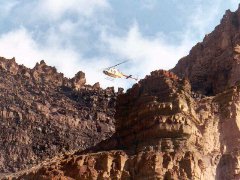 |
|
Helicopter taking out short-trippers at Whitmore Wash. |
After running a few miles to Whitmore Wash, (Mile 188) we pulled in at a wide sandbar to take a relief stop, and to take a short hike up to some old Anzani pictographs. Here, we met an irritating noise -- the comings and goings of a couple of helicopters. There's a landing pad up in the rocks above a beach just upriver, and we'd seen the Hatch party there, rolling up side tubes of two of their rafts, getting set to make the long trek to South Cove empty.
That landing pad is a familiar spot to the ARR crews, Dick told us. ARR's six and seven day trips end there, with the passengers being flown out by helicopter to the Bar-10 Ranch on the north rim. Since the boats still have to get downriver anyway to be taken from the Water, ARR uses them for three-day trips. People are picked up in Las Vegas, flown to the Bar-10, where they get to do some dude ranch things like ride horses, have a campfire, and hear a group of western singers. After a night in the bunkhouse, they're flown down to the landing pad on one of the helicopters, being exchanged with the customers that have ridden the rafts down from Lee's Ferry. They then run the river on down to Separation Rapids (Mile 240), making a couple stops along the way, and then are met by a jet boat, which takes them down to Lake Mead, and are bussed back to Las Vegas. It must make a pretty interesting three-day adventure for people that want a taste of the life style.
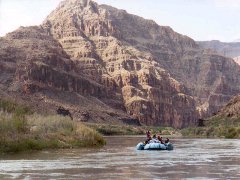 |
|
Josh's raft following us below Whitmore Wash. |
Getting organized, we got back on the river. By now, it was overcast again, still cool, and the wind was blasting up the river at us again, reviving the sort of thoughts we had the afternoon before. The Canyon continued wide, with many distant views, and only gentle rapids which we rode through without much comment. Joe took the opportunity today to give his future brother-in-law a few tastes of handling the raft on the river and in the rapids, and I have to admit that Jay did pretty good, after a few early uncertainties and some wobbling around, getting the feel of it. As the day wore on, he was confident enough to be running some fairly moderate rapids with it.
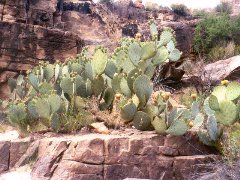 |
|
Prickley Pear cactus at our lunch stop on the seventh day. |
The continued wind and overcast was getting everybody down, and we were glad to pull into a nameless beach somewhere around Mile 196 for lunch. In reverse of my usual practice, I found a little spot to sit in what sun there was to warm up, and perhaps dry out a little, and while I sat there, the sun came out to more or less stay out, and the wind dropped, turning what had been a moderately miserable morning into a pretty good afternoon, so it was good to get back on the rafts and get moving again, even though we knew we were moving toward the end of the trip. Lunch today was tuna salad sandwiches, but with the number of green peppers evident, I decided to hit the peanut butter and jelly line along with the vegetarians.
Not long after lunch, we were passed by the three Hatch boats, now with side tubes rolled up and stacked on the decks, running hard for Lake Mead. We waved at each other, but they had a long way to go and didn't stop to talk. Also, not long after lunch, we came across a private trip, of what looked to be about nine oar rafts, all rafted up in a huge cluster around one raft that had a motor. As we drew close, a guy in one raft held up a big sign that said "ice", and Joe headed over to talk to them, figuring that we had ice to spare, and they were probably about seventeen days out and theirs had given out. We stopped to talk for a moment, and as we were pulling apart, someone mentioned that the guy that was running the outboard had been out of cigarettes for two days, and was getting pretty cranky. Having been there and done that, and given that us smokers are few and far between in a place like this and have to stick together, I yelled at Joe to turn around and go back. While he circled back, I dug frantically in my day bag for a spare pack that I knew I wouldn't need today. Joe pulled up alongside, and I clambered out on the side tube and handed the pack across, still wrapped in a zip-loc bag. I got a cheer from the whole private trip -- I guess there would be peace in camp that night -- and a heartfelt thanks from the guy at the motor. I'd liked to have been with them -- we'd only been out seven days; it seemed pretty short, and we'd covered a lot of ground in a short time. We ran across another private trip shortly afterward, pulled up on shore to camp for a lazy afternoon, and again I wished that I could have been out there with them, rather than rushing down the river on this motor raft.
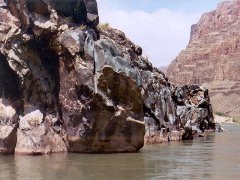 |
|
Lava flow carved up by an active river. |
Somewhere around Mile 200, we reached Lower Granite Gorge. The Canyon, which had been wide above, with few notable rapids (except, of course for Lava the day before) narrowed to the familiar steep walls lofting far overhead, and we began to hit rapids. Many of the rapids in this part of the Canyon bear no names, or only familiar ones. The first serious one we hit was 205 Mile, known as "Kolb", followed not too much more by 209 Mile, where a fairly health rapid flows around a large, low, rocky island. Three miles farther on, 212 Mile ("Little Bastard"), shorter, but just as bad. A mile below that, Joe cut the engine for a minute so we could look at Pumpkin Spring, a hot spring, but polluted with radioactivity. We stayed on the boats and took pictures, then ran on to 217 Mile Rapid, the last tough one for a few miles, although smaller ones continued to go by.
Soon, up ahead, we could see the conical mount of Diamond Peak up ahead. Joe told us that it stood 1800 feet above the river, about as far as we had descended in the time we had come from Lee's Ferry. We ran another couple small rapids, and came up on Diamond Creek Wash at Mile 226, which has a dirt road down to a landing at the bottom, the first place that wheeled vehicles could reach the river since Lee's Ferry a week before. Several snout rafts were there, used by the Havasaupi Indian rafting company, which does day trips down to Separation Canyon out of there. Most private trips and commercial trips end here, rather than running the lowest part of the Canyon, which includes many miles over the flat surface of Lake Mead, so from there on down the rest of the Canyon is much less well known. That's a shame, for below Diamond Creek, the walls of the Canyon closed in again, becoming reminiscent of the Upper Gorge above Phantom Ranch. Here, we hit some very pretty countryside and the best rapids we'd seen all day, a sort of going-away present from the Canyon.
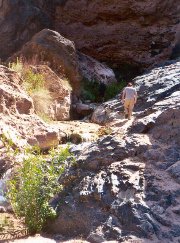 |
|
Hiking up alongside the stream in Travertine Canyon. |
We ran Diamond Rapids, just below the landing, Not much farther was Travertine Canyon and Travertine Rapid. We came to a stop here, in the middle of the rapid, for a last hike up a side canyon, to a small waterfall. The first part of the hike was up through a sand filled field of boulders, but soon there were sand paths and small waterfalls. The upper falls was up a steep, smooth rock that I didn't feel like challenging, so I settled for taking some pictures in the lower area, then found a spot of shade to take in one last break on the river. My attention was drawn by a pair of tiny lizards, perhaps three inches long, chasing each other's tails and running over and around the rocks, and I sat and watched them for quite a while.
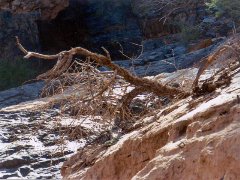 |
|
The route up to Travertine Falls. |
After a while, people began trickling back to the boats, bringing tales of a hairy climb to the top of the big waterfall, and once again we got on board the boats. We ran the rest of Travertine Rapid, and shortly came to Travertine Falls, which has a stalagmite-type flowstone cascading down over the cliffs, a thin trickle of water going down it, leaving behind minerals that created the formation. We pressed on on to 231 Mile Rapid, the biggest we'd see all day. Joe told us that was here that the most recent flip of one of the big motor rigs had occurred, only a couple years before. The crew had dropped their customers, and were running without side tubes at low water, so were less stable. Two boats got a little crossed up; some carnage ensued, and some equipment was lost, but apparently no one was hurt. Joe didn't say it, but I got the impression that the accident may have been contributed to by the crew hitting the leftovers in the drag bags a little heavily while rolling up the side tubes on a hot day.
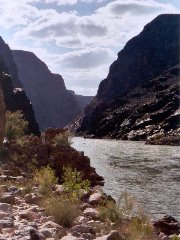 |
|
View downstream from Travertine Canyon Landing. Starting to run out of river, now. |
The last rapids came at us in quick succession -- 231 Mile, 232 Mile, 234 Mile, Bridge Canyon at 235 Mile, then Gneiss Canyon at 236 Mile. In the middle of that last rapid, where Gneiss Canyon feeds in from river right, we ran across the Grand Canyon Expeditions party again, pulled up in what looked to me to be a very pretty if rather narrow campsite. Joe hadn't planned on stopping there, but pressed on. By now, the waters of Lake Mead were starting to be felt, and in normal times Gneiss Canyon is the last rapid, but in the lowering water, 237 Mile Rapid had started to come up -- nothing much, but a welcome addition back to the world.
Not far below 237 Mile, Joe announced that we were now on Lake Mead, and that life jackets were no longer required to be worn. We quickly peeled them off and stuffed them in a large net bag that was produced from some hidden corner of the motor well, and feeling strangely light and unencumbered ran off the last mile of the day, to a campsite nestled along the shore on river left. Joe called it Bridge Canyon, although that's actually upstream, but it was here that a crew lived for months, decades ago, surveying for the proposed Bridge Canyon Dam that would have flooded the Canyon clear back up to Havasu Creek and beyond. Fortunately, it was never built, but we could still see the rockwork, far above the river, where the survey crews had their camp and groovers.
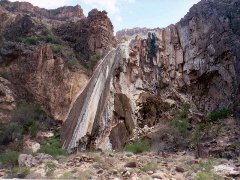 |
|
Travertine Falls -- the rock formation is created by minerals carried in the water. |
We stayed on the boats for a few minutes while Joe went over how we would turn in our gear and pack in the morning, before we got off the boats and went looking for a campsite. I didn't see a lot of promising possibilities in the tamarisks above the river, and there was a large rock bed right in there. I was just about to settle for a soft spot near the end of the beach, because I wanted to be close to the river, when I took another look at a spot I'd passed by earlier a couple of times. It was a small, almost circular alcove in the rock field, filled with hard sand. It had looked too small, but it was protected from most wind that might come up, so I climbed up the few steps and paced it off. Yes it was small -- but it was just big enough. Here, for the last time, would be my home for the night on the Colorado River -- at least for this trip.
It felt good to get out of my clothes, wet from the last rapids, to lay them out on the still-warm rocks, even though the sun was already behind the cliffs by this time. I pulled on the polypro again, and, most appreciated, my carefully-husbanded set of dry socks and camp shoes. That made all the difference in the world; things were right again. Reorganizing the gear was a little different tonight, as it had to be packed not for the river tomorrow, but for the airliner -- I was planning on carrying my daypack onto the plane, but wasn't sure I would be able to carry on the duffle bag, so wanted to make sure that nothing really valuable, like camera or film or notes was exposed to baggage handlers.
It took a while to get that done, but once completed, I sat on the pillow, leaned back against the rock wall, and just took in the last camp scene until the call came for dinner. Dinner turned out to be steak and mashed potatoes, real ones, and very good too, although it was hard to cut the steak with my pocket knife while I was eating out of my lap. After dinner, I sat around with others and shared generally good feelings about the trip.
After a while, Joe got everyone in a circle around a last Dura-Log in the fire pan, and we talked about our feelings about the trip. Mine were still mixed -- it had been a great trip, but I still had felt rushed. But what I told the group was that they were a rare bunch of people. Considering the thousands or tens of thousands that fly into Las Vegas party each day, only a relative handful of us had made it out onto the river to enjoy the real wonders of this part of the world, rather than the artificial thrills and fantasies of the cities. The guides, both boatmen and helpers, are seriously neat people, living a life that they love in a place that they love, and I envy them for it. They work hard and the money is probably not the greatest, but they are much appreciated. Joe had done an especially good job of interpreting the Canyon and its wonders. Many years ago, I had the opportunity to attend a couple courses at the National Park Service Interpretive School at Harper's Ferry, and learned how much is involved in being able to do that, and Joe had done a great job. I know that his love of the Canyon had led him to improve his skills in this area, even to have taken that seminar trip a few weeks before.
After a while, the circle broke up, and people drifted off to bed. I hung around for a bit, then headed up to the alcove, got ready to go to bed, kicked back, and looked at the stars until I couldn't stay awake any longer.




